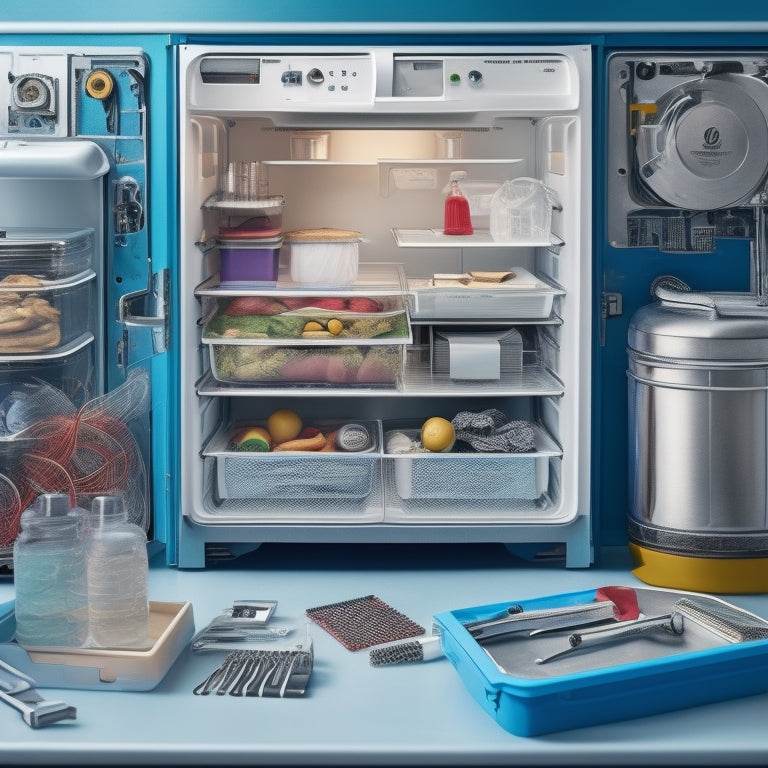
USA's Appliance Expert Solves GE Fridge Mysteries
Share
As the USA's leading appliance expert, I have dedicated my expertise to demystifying General Electric (GE) refrigerator issues. Decoding error codes is key to identifying root causes and pinpointing faulty components. Regular maintenance is vital, including cleaning condenser coils, inspecting water filters, and scheduling preventative checks. Common issues such as faulty temperature control can be resolved by checking door seals and evaporator fan function. By exploring these troubleshooting strategies, homeowners can guarantee their GE fridge operates at peak performance, and uncovering these expert solutions will reveal a wealth of knowledge to optimize appliance longevity.
Key Takeaways
• Decoding GE fridge error codes helps identify root causes and pinpoint faulty components for targeted repairs and minimized downtime.
• Regular maintenance, including cleaning condenser coils and inspecting door seals, ensures peak performance and efficiency.
• Effective troubleshooting strategies involve inspecting evaporator fans, temperature control, and air circulation to resolve common issues.
• Mastering maintenance involves preventative checks, addressing potential faults promptly, and ensuring proper appliance operation.
• Expert solutions include decoding error codes, performing routine checks, and addressing issues promptly to guarantee peak performance and longevity.
Decoding GE Fridge Error Codes
When troubleshooting a GE fridge, deciphering error codes is often the first step in identifying the root cause of the issue, as these codes provide valuable insights into the specific malfunction or fault affecting the appliance.
Error code troubleshooting is a vital step in resolving the problem efficiently. Understanding GE fridge alerts is essential to pinpoint the faulty component or system, allowing for targeted repairs.
By decoding these codes, homeowners can diagnose issues such as faulty temperature sensors, ice maker malfunctions, or compressor failures. This knowledge enables them to take corrective action, minimizing downtime and reducing the risk of further damage.
Effective error code troubleshooting is key to maintaining a well-functioning GE fridge and ensuring peak performance.
Mastering SXS Refrigerator Maintenance
Proper maintenance of a GE side-by-side refrigerator requires a combination of regular cleaning, component inspection, and proactive fault prevention to guarantee peak performance and extend its lifespan. By investing time in routine maintenance, you can avoid costly repairs and make sure your appliance operates efficiently. To achieve this, focus on the following key aspects:
-
Regular cleaning: Make certain the condenser coils, drain, and door seals are clean and free from debris.
-
Component inspection: Check the refrigerator's water filter, ice maker, and evaporator fan for signs of wear or damage.
-
Preventative maintenance: Schedule regular checks to prevent issues before they arise, ensuring efficient troubleshooting and reducing downtime.
- Fault prevention: Identify and address potential faults before they become major problems, saving you time and money.
Solving Common GE Refrigerator Issues
Fault diagnosis is a vital aspect of refrigerator maintenance, as identifying and addressing issues promptly can prevent minor problems from escalating into costly repairs. When it comes to GE refrigerators, common issues include faulty temperature control, inadequate cooling, and mysterious leaks.
To troubleshoot these problems, start by inspecting the door seals and gaskets for signs of wear or damage. Next, check the condenser coils for dust and debris, and make sure proper air circulation around the appliance.
Optimizing cooling performance involves confirming the refrigerator is level, cleaning the condenser coils regularly, and verifying the proper functioning of the evaporator fan. By following these steps, you'll be well on your way to resolving common GE refrigerator issues and enjoying a trouble-free cooling experience.
Frequently Asked Questions
Can I Use My GE Fridge in a Garage or Outdoor Kitchen?
When contemplating outdoor or garage installation, make sure your GE fridge operates within the recommended garage temperature range (39°F-90°F) and is protected from excessive outdoor humidity, which can compromise performance and longevity.
How Often Should I Clean the Condenser Coils on My SXS Refrigerator?
'Just like a well-oiled machine, your SXS refrigerator relies on clean condenser coils to run efficiently. Schedule coil cleaning every 3-6 months to prevent overheating and reduce energy bills, setting reminders to guarantee consistent fridge maintenance.'
Are All GE Fridge Models Compatible With Smart Home Devices?
Not all GE fridge models are compatible with smart home devices, as smart integration is limited to specific models with built-in Wi-Fi capabilities, and device limitations vary depending on the appliance's features and firmware.
Can I Install My GE Refrigerator on a Carpeted Floor?
When installing a GE refrigerator on a carpeted floor, make sure there is adequate floor clearance to prevent moisture accumulation and restricted airflow, which can lead to carpet moisture issues and compromise appliance performance.
Does My GE Fridge Warranty Cover Repairs for Cosmetic Damage?
Regarding cosmetic damage repairs, GE fridge warranties typically exclude coverage for aesthetic issues, considering them non-essential to the appliance's functionality, unless explicitly stated in the warranty terms, where cosmetic repairs may be included.
Related Posts
-

Elevate Your Dance Choreography With Top Video Editing Tools
You're just a few clicks away from maximizing your dance choreography potential! With top video editing tools like Ad...
-

Top Performance Headbands for Fitness Enthusiasts
When you're looking for top performance headbands, focus on options that combine advanced moisture-wicking fabrics wi...
-

Dance Maestro Zoe Rappaport Steals the Spotlight
Zoe Rappaport's illustrious career has cemented her status as a visionary Maestro, driving innovation in movement dir...


